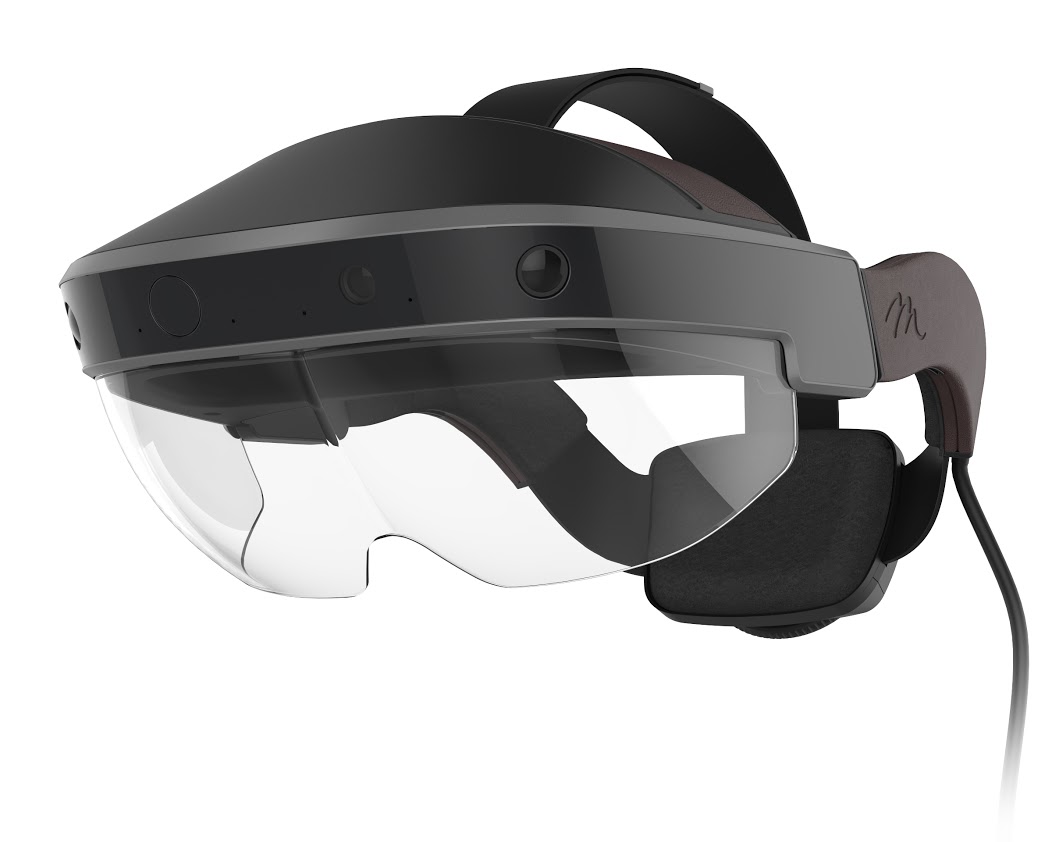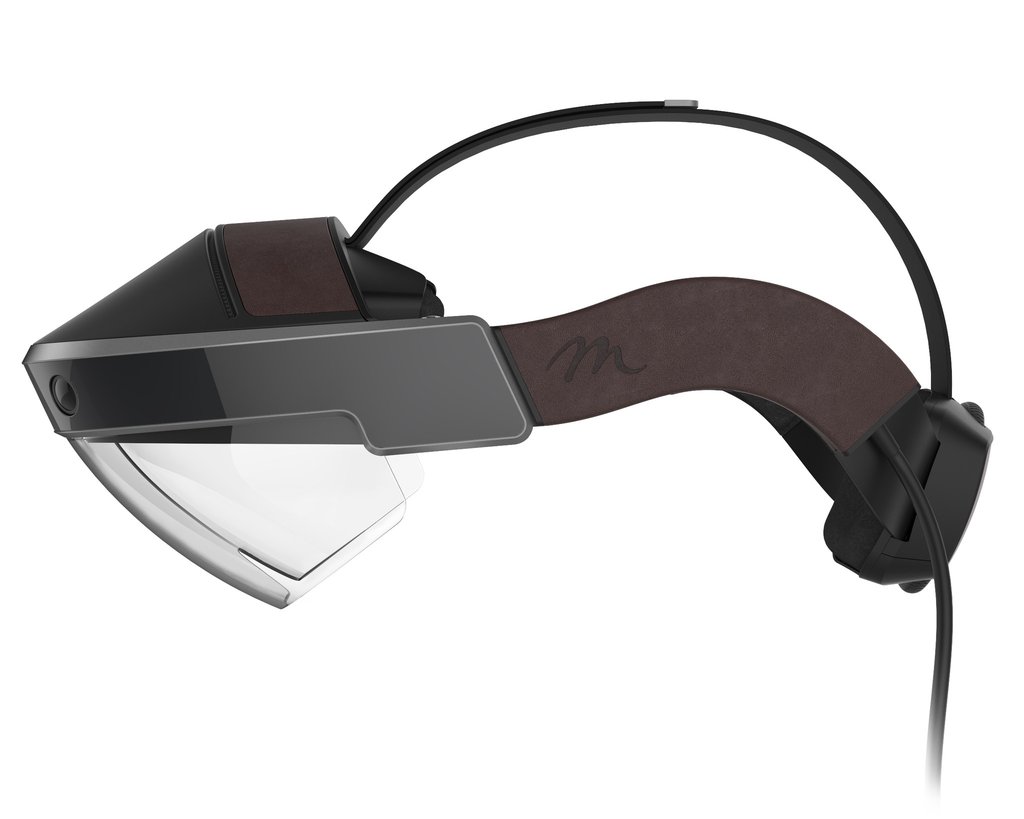Age Of AR Dawning: Meta 2 AR Glasses Now Shipping
Meta announced that shipments of the Meta 2 augmented reality developer kits have begun. Welcome to the age of augmented reality. Meta 2 AR glasses are about to land in the hands of developers around the world, and there’s no telling what these devs will create.
Meta’s second generation AR glasses are arguably the first compelling, consumer-accessible AR device. Tom's Hardware's Rexly Peñaflorida II was “astounded” by the experience when he tried Meta 2 AR glasses at GDC. He also said that Meta “is a step or two ahead of Microsoft in terms of development.”
Microsoft’s Hololens is in a somewhat different league, as it features a self-contained computer system inside the unit, but the Hololens doesn’t offer the same level of user experience. The Hololens dev kit provides a small window of AR that doesn’t come close to filling your field of view. Meta’s Meta 2 AR Glasses offer a much larger augmented screen area. The Meta 2 headset has a 2560x1440 resolution image, with a 90-degree field of view. The Meta 2 isn’t a self-contained device, though; it requires a computer.
Like Microsoft’s Hololens headset, Meta 2 includes an inside-out tracking system and hand-tracking technology. The headset features a 720p front-facing camera, sensors to capture depth and hand movement, and a 6-axis IMU to track orientation. It also includes a nine-foot tether cable to allow you to move around somewhat.
Meta began accepting preorders from the general public for the Meta 2 AR glasses in March. You might think that the first people to order the kit would be the first people to receive theirs, but Meta is taking a calculated approach to its hardware release. Meta is shipping the first kits to “select individual and enterprise developers who will be working closely with Meta to explore the exciting capabilities of the Meta 2 Development Kit.”
Meta 2 Developer Kits include a Unity-based software developer kit to help developers get started. The Meta 2 glasses also support several Windows-based applications.
Meta is currently selling the Meta 2 Developer Kits for $949, but that price is about to change. The company said that the price is going up next year.
Get Tom's Hardware's best news and in-depth reviews, straight to your inbox.
| Header Cell - Column 0 | Meta 2 AR Developer Kit |
|---|---|
| Display | 2560 x 1440 resolution, 90-degree FoV |
| Camera | 720p front-facing camera |
| Sensors | 6-axis IMU, array for hand interactions and positional tracking |
| Audio | Four speaker near-ear audio |
| Connectivity | 9-foot cable for video, data, and power (HDMI 1.4b or DisplayPort) |
| Weight | 420g without the cable and head straps |
| Application Support | - Microsoft Office |
| Row 7 - Cell 0 | |
| - Adobe Creative Suite | |
| Row 9 - Cell 0 | |
| - Spotify | |
| System Requirements | - Intel Iris Pro / Nvidia GT 650M / AMD Radeon HD7970 |
| (recommend Nvidia GTX 960 / AMD 280 equivalent or greater) | |
| Row 13 - Cell 0 | |
| - Intel i7-3610MQ equivalent or greater | |
| Row 15 - Cell 0 | |
| - 8 GB RAM | |
| Row 17 - Cell 0 | |
| - HDMI 1.4 video output | |
| Row 19 - Cell 0 | |
| - 1x USB 3.0 ports | |
| Row 21 - Cell 0 | |
| - Windows 8.1 or newer | |
| Row 23 - Cell 0 | |
| - 64 bit Unity 5+ on Windows (for development, not end users) |
Kevin Carbotte is a contributing writer for Tom's Hardware who primarily covers VR and AR hardware. He has been writing for us for more than four years.
-
Jeff Fx I'll accept a tether, since it allows a larger FOV and more complex apps and games than a self-contained unit can handle, but it would be nice if they could work with the people who make a wireless adapter for the Vive to untether this HMD.Reply -
bit_user Reply
Tether is a deal-breaker for many AR apps. This is one thing MS got right, and the tradeoff vs rendering horsepower is probably the main reason why it's so much lower spec than Meta (in terms of resolution, FoV, etc.).19036519 said:I'll accept a tether, since it allows a larger FOV and more complex apps and games than a self-contained unit can handle,
Have you tried that adapter? I'm pretty sure its latency is no better than anything else we've heard about, recently. In other words: too high.19036519 said:but it would be nice if they could work with the people who make a wireless adapter for the Vive to untether this HMD. -
problematiq Reply19037513 said:
Tether is a deal-breaker for many AR apps. This is one thing MS got right, and the tradeoff vs rendering horsepower is probably the main reason why it's so much lower spec than Meta (in terms of resolution, FoV, etc.).19036519 said:I'll accept a tether, since it allows a larger FOV and more complex apps and games than a self-contained unit can handle,
Have you tried that adapter? I'm pretty sure its latency is no better than anything else we've heard about, recently. In other words: too high.19036519 said:but it would be nice if they could work with the people who make a wireless adapter for the Vive to untether this HMD.
The adapter is not using 802.11a/b/g/n/ac it's using 802.11ad (60ghz, 6.75 Gbit/s) it does add latency but so little it's not noticeable.
-
bit_user Reply
13 ms definitely is a noticeable amount of latency, in VR.19037998 said:The adapter is not using 802.11a/b/g/n/ac it's using 802.11ad (60ghz, 6.75 Gbit/s) it does add latency but so little it's not noticeable.
Let me know when you've tried it. That's all I'm saying.
-
SockPuppet You have a MAXIMUM of 20 milliseconds from the time the user moves their head, to the time the screen needs to be updated and firing a photon at the user's eye. 20ms for the entire render pipeline. this device adds AT LEAST 10ms to the equation in perfect conditions. That's half of your VR latency budget right there.Reply
Some day, we will have wireless connections from HMD to PC that don't add latency. That day isn't going to be for at least two more years. -
bit_user Reply
I'd put money on something before then.19042773 said:Some day, we will have wireless connections from HMD to PC that don't add latency. That day isn't going to be for at least two more years.
If you can do ATW in the HMD, then that buys you a lot. Since the HMD contains the sensors, it can use the very latest position information.
Beyond that, I think using some simple form of video compression and transmitting one eye at a time would be the next obvious improvements. But these are things you really want to do inside the video card. So, that will require a new generation of GPUs, with a new interface connector. And that is probably at least 2 years away. -
d_kuhn I'm all for more resolution... but I'm skeptical that Meta is going to really match the capabilities that Hololens brings to the table. Even ignoring the crippling tethering problem, there's a lot going on under the hood of hololens, it'll be very interesting to see if the Meta will REALLY outgun it. I've not had a chance to play with Meta so am interested to hear what users think... but the demos I've seen online completely lack the sense of 'connectedness' to the outside world that is inherent in Hololens. The display tech they use also seems like it's going to be limited. It has resolution but it appears to be bouncing the images off a polarized film to the eye - that's going to result in a 'less dense' image. It'll be great at semi-transparent objects... but it will struggle with opaque objects. Hololens also struggles with opaque when the background is very bright but is MUCH better than the other AR approaches I've tried (that use polarizers). In any case... very cool that there's competition, I think AR is AT LEAST as interesting as VR... and competition is always a good thing.Reply -
John_561 Reply19039242 said:
13 ms definitely is a noticeable amount of latency, in VR.19037998 said:The adapter is not using 802.11a/b/g/n/ac it's using 802.11ad (60ghz, 6.75 Gbit/s) it does add latency but so little it's not noticeable.
Let me know when you've tried it. That's all I'm saying.
13 thousandths of a second is noticeable to you? What, are you frickin Data from STtNG that you notice that little of a time parcel? XD Happy NY all. <3
-
bit_user Reply
You don't perceive it as a delay between action and event. It's perceived at a sub-conscious level. When latency gets too high, VR becomes nauseating to the user.19065000 said:
13 thousandths of a second is noticeable to you? What, are you frickin Data from STtNG that you notice that little of a time parcel?19039242 said:13 ms definitely is a noticeable amount of latency, in VR.
Let me know when you've tried it. That's all I'm saying.
The reason for making you feel sick is that a lot of poisons, in the natural world, cause a similar delay between movement and perception. So, the brain detects this and triggers your body to vomit the poisonous thing you probably just ate.
Unfortunately, that evolutionary benefit works against us on laggy VR systems.
BTW, what we're talking about is not 13 ms of absolute latency, but 13 ms of additional latency, on top of what the VR system already had. That's how long it takes to transmit a frame @ the bitrate quoted by problematiq.

